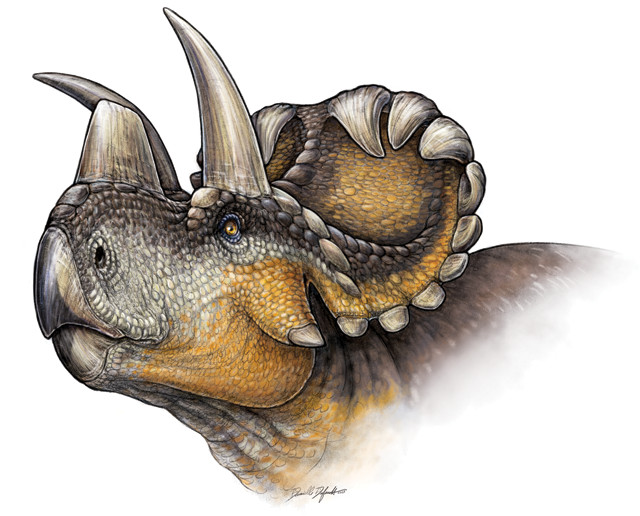
by Mary Caperton Morton Tuesday, October 20, 2015

An artist's drawing of the spectacularly adorned Wendiceratops. Credit: Danielle Dufault.
The discovery of a 79-million-year-old frilled and horned relative of Triceratops is shedding light on the early evolution of the ceratopsid’s distinctive look. The new specimen, discovered in a quarry in southern Alberta, Canada, and described recently in PLOS ONE, was named Wendiceratops pinhornensis after the famed fossil hunter Wendy Sloboda of the University of Lethbridge in Alberta, who discovered the site in 2010.
Approximately 6 meters long and weighing more than a ton, Wendiceratops sported a remarkably adorned skull, with a wide, shield-like frill bearing hook-like horns that curled forward, as well as a nasal horn and possibly horns over its eyes.
“Wendiceratops helps us understand the early evolution of skull ornamentation in an iconic group of dinosaurs characterized by their horned faces,” said David Evans of the Royal Ontario Museum in Toronto, Canada, a co-author of the study, in a statement. “The number of gnarly frill projections and horns makes it one of the most striking horned dinosaurs ever found.”
The skull, found along with about 200 other bones, shows evidence of a tall nasal bone, much like a rhinoceros, although the specimen is fragmentary and the exact shape of the nasal bone is unknown. The find represents the earliest-known occurrence of a tall nose horn in a ceratopsid, giving scientists a better idea of when the distinctive feature evolved. The discovery also means that nasal horns must have evolved at least twice in the horned dinosaur family, once in the short-frilled Centrosaurinae group that includes Wendiceratops, and again in the long-frilled Chasmosaurinae group that includes Triceratops. Such adornments are thought to have been used for defense and sexual selection.
A full-sized skeleton and exhibit profiling Wendiceratops are on display at the Royal Ontario Museum in Toronto.
© 2008-2021. All rights reserved. Any copying, redistribution or retransmission of any of the contents of this service without the expressed written permission of the American Geosciences Institute is expressly prohibited. Click here for all copyright requests.